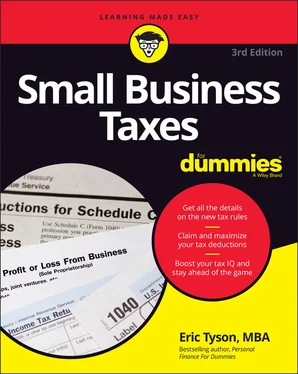These limits increase annually with inflation.
Limiting interest deductions
Effective with 2018, companies with annual gross receipts of at least $25 million on average over the prior three years are limited in their deduction of interest from business debt. Net interest costs are capped at 30 percent of the business’s earnings before interest, taxes, depreciation, and amortization (EBITDA). Farmers and most real estate companies are exempt.
Effective in 2022, this provision actually gets more restrictive and would thus effect even more businesses. At that point, the 30 percent limit will apply to earnings before interest and taxes.
Reducing meal and entertainment deductions
The tax reform bill of 2017 eliminated the entertainment expense deduction for businesses. Under prior tax law, 50 percent of those expenses was deductible, for example, when a business entertained customers and even employees at sporting events, fitness clubs, and restaurants.
The new rules do include some exceptions. On-site cafeterias at a company’s offices and meals provided to employees as well as business meals associated with travel are 50 percent deductible. Meals provided to prospective customers as part of a seminar presentation are still fully deductible. Holiday parties and company picnics are also fully deductible as long as they are inclusive of everyone.
 In early 2021, the Consolidated Appropriations Act 2021 introduced a temporary 100 percent deduction for expensing business meals purchased from “qualifying restaurants” from January 1, 2021, through December 31, 2022 (tax years 2021 and 2022). Qualifying restaurants per the IRS are establishments that prepare and serve food and beverages for immediate consumption, either on or off-premises.
In early 2021, the Consolidated Appropriations Act 2021 introduced a temporary 100 percent deduction for expensing business meals purchased from “qualifying restaurants” from January 1, 2021, through December 31, 2022 (tax years 2021 and 2022). Qualifying restaurants per the IRS are establishments that prepare and serve food and beverages for immediate consumption, either on or off-premises.
Eliminating the health insurance mandate
Since the Affordable Care Act (also known as Obamacare) was passed by Congress in 2010, some Republicans in Congress vowed to repeal it. With the election of Republican Donald Trump in 2016, it seemed that the pieces were in place for Obamacare’s successful repeal. But, Republicans fell one vote short in the Senate when the late Arizona Senator John McCain gave the repeal measure his infamous thumbs-down vote.
So, the 2017 tax bill included a little known or discussed measure that eliminated Obamacare’s mandate effective in 2019, which required people to have or buy health insurance coverage and if they didn’t, they’d face a tax penalty. So, the penalty tax also disappeared in 2019.
Revising rules for using net operating losses
Net operating losses (NOLs) can no longer be carried back for two years. However, NOLs may now be carried forward indefinitely until they are used up. Previously the carryforward limit was 20 years (the CARES Act allowed 2018–2020 NOLs to be carried back five years).
NOLs are limited each year to 80 percent of taxable income.
Considering the SECURE ACT of 2019 and COViD-19 Relief Tax Acts
A number of smaller tax-related bills passed in recent years made some changes that affect small businesses. These bills include the SECURE (Setting Every Community Up for Retirement Enhancement) ACT of 2019 as well as the COVID-19 relief bills. Here are the highlights of the SECURE Act that small business owners should be aware of:
Small-business owners are eligible for up to $5,000 in tax credits when starting a retirement plan. This credit applies to new 401(k), profit sharing, SEP, and SIMPLE plans for small employers with up to 100 employees.
More part-time workers can participate in company 401(k) plans. Previously, employees had to work at least 1,000 hours per year to take part in a company’s 401(k) plan. Now, workers who achieve at least 500 hours over three consecutive years may participate.
You can withdraw up to $5,000 per parent penalty-free from your retirement plan for a “qualified birth or adoption distribution” for the birth or adoption of a child. This new provision waives the normal 10 percent early withdrawal penalty and allows you to repay the withdrawn money as a rollover contribution.
Required minimum distributions (RMDs) from retirement accounts begin at age 72, not 70½. This gives you more options and flexibility, but delaying required distributions which are based upon your life expectancy may or may not be in your best long-term interests. It’s impossible to know for sure, but you and/or your tax advisor may want to crunch some numbers, which requires making some assumptions, to see what the optimal age is to begin your RMDs.
You can make traditional IRA contributions past age 70½ so long as you continue earning employment income. This will bring the contribution rules for these accounts into alignment with those for Roth IRAs and 401(k)s.
Contemplating Potential Upcoming Tax Law Changes
Congress continually tinkers with our nation’s tax laws. Bigger changes tend to occur when the same party controls both chambers of Congress as well as the Presidency. As this book goes to press in late 2021, we have been through a lengthy period where there has been lots of talk of tax increases by the Democrats, the party currently in control of Congress and the Presidency, but that has largely been blocked to date due to their super slim majorities in both the House and Senate.
With the 2022 Congressional mid-term elections on the horizon, history suggests that the most likely outcome for those elections will be divided government, which will mean even more gridlock and less likelihood for tax increases or tax changes in general. That said, here’s a short list of changes that have been discussed and that have the highest likelihood of being part of a tax package within the next year, if one ever passes:
Higher federal income tax rates on high-income earners
Some elimination of the step-up cost basis at death for investors in the highest tax brackets
Expansion of the state and local income tax deduction from $10,000 to some higher amount
Increased corporate federal income tax rate
Higher federal capital gains tax rate for those in the highest federal income tax brackets
Reduction in the federal estate exemption amount
Application of the Social Security tax to more income for the highest income earners
Understanding the Different Types of Taxes You Pay and Your Tax Rates
 Most small business owners pay income taxes at the personal income tax rates. That’s because the vast majority of small businesses are run as sole proprietorships. And many of those that aren’t, such as partnerships, LLCs, and S corporations, pass through their income in such a way that the income is generally taxed to its recipients as personal income. Some small business owners pay a corporate rate if their business is incorporated as a regular so-called C-corporation. (The type of business entity you elect is discussed in Chapter 2.) See the later section “ Corporate income tax rates” for more details.
Most small business owners pay income taxes at the personal income tax rates. That’s because the vast majority of small businesses are run as sole proprietorships. And many of those that aren’t, such as partnerships, LLCs, and S corporations, pass through their income in such a way that the income is generally taxed to its recipients as personal income. Some small business owners pay a corporate rate if their business is incorporated as a regular so-called C-corporation. (The type of business entity you elect is discussed in Chapter 2.) See the later section “ Corporate income tax rates” for more details.
When it comes to federal income taxes, many people remember only whether they received a refund or owed money. But you should care how much you pay in taxes and the total and marginal taxes that you pay so you can make decisions that lessen your tax load. Although some people feel happy when they get refunds, you shouldn’t. A refund simply signifies that you overpaid your taxes during the previous year. When you file your income tax return, you settle up with tax authorities regarding the amount of taxes you paid during the past year versus the total tax that you’re actually required to pay, based on your income and deductions.
Читать дальше

 In early 2021, the Consolidated Appropriations Act 2021 introduced a temporary 100 percent deduction for expensing business meals purchased from “qualifying restaurants” from January 1, 2021, through December 31, 2022 (tax years 2021 and 2022). Qualifying restaurants per the IRS are establishments that prepare and serve food and beverages for immediate consumption, either on or off-premises.
In early 2021, the Consolidated Appropriations Act 2021 introduced a temporary 100 percent deduction for expensing business meals purchased from “qualifying restaurants” from January 1, 2021, through December 31, 2022 (tax years 2021 and 2022). Qualifying restaurants per the IRS are establishments that prepare and serve food and beverages for immediate consumption, either on or off-premises. Most small business owners pay income taxes at the personal income tax rates. That’s because the vast majority of small businesses are run as sole proprietorships. And many of those that aren’t, such as partnerships, LLCs, and S corporations, pass through their income in such a way that the income is generally taxed to its recipients as personal income. Some small business owners pay a corporate rate if their business is incorporated as a regular so-called C-corporation. (The type of business entity you elect is discussed in Chapter 2.) See the later section “ Corporate income tax rates” for more details.
Most small business owners pay income taxes at the personal income tax rates. That’s because the vast majority of small businesses are run as sole proprietorships. And many of those that aren’t, such as partnerships, LLCs, and S corporations, pass through their income in such a way that the income is generally taxed to its recipients as personal income. Some small business owners pay a corporate rate if their business is incorporated as a regular so-called C-corporation. (The type of business entity you elect is discussed in Chapter 2.) See the later section “ Corporate income tax rates” for more details.










